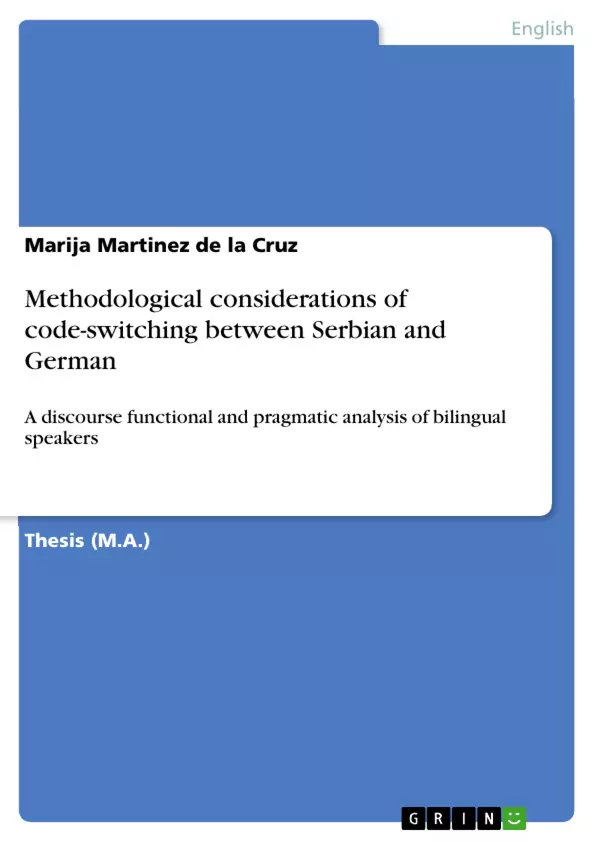The present study examines natural production code-switching data between Serbian and German. The data in this study is based on audio recordings of naturally occurring interactions among Serbian-German bilinguals. These conversations were recorded in everyday situations in order to capture spontaneous formulated code-switching patterns. In order to analyse this data collection, it was considered from a grammatical and socio-functional perspective within the framework of the theoretical part of this thesis. During the analysis, the main goal has been to identify the discourse functional and pragmatic aspects that motivate the presence of code-switching and therefore to give an explanation why bilingual speakers alternate between two languages. Thus, the analysed Serbian-German conversations shared some coincidences with the examples of the theoretical part, but also implicated other code-switching occurrences which served important functions in the communities where it was used.
Inhaltsverzeichnis (Table of Contents)
- 1.0. Introduction
- 1.1. Aims and content
- 2.0. Introduction to code-switching
- 2.1. Characterisation and definition of code-switching
- 2.2. Prior research on code-switching
- 2.3. Code-switching between multilingualism, language choice and identity
- 3.0. The functional approach to code-switching
- 3.1. Sociolinguistic introduction to code-switching
- 3.2. Discourse functional code-switching by Gumperz
- 3.3. Functional and interactional code-switching by Auer
- 3.4. The Markedness Model by Myers-Scotton
- 4.0. Three grammatical models of code-switching
- 4.1. Introduction to the grammatical approach to code-switching
- 4.2. Types of code-switching
- 4.3. The Variation Theory of Poplack and Sankoff (1981)
- 4.4. The Government and Binding theoretical approach of Di Sciullo, Muysken and Singh (1986)
- 4.5. The Matrix Language Frame Model by Myers-Scotton
- 5.0. An Empirical Study: Pragmatics of Serbian-German code-switching
- 5.1. Introduction to study
- 5.2. Data collection and methodology
- 5.3. Data analysis
- 5.3.1. Discourse functional and pragmatic aspects of code-switching from a grammatical perspective
- 5.3.1.1. Code-switching as insertion
- 5.3.1.2. Code-switching as a case marker
- 5.3.1.3. German verbs with Serbian inflectional morphology
- 5.3.1.4. Identification of the matrix language in Serbian and German code-switching
- 5.3.2. Discourse functional and pragmatic aspects of code-switching from a socio-functional perspective
- 5.3.2.1. Conversational functions of Serbian and German code-switching
- 5.3.2.2. We-code and They-code in Serbian and German
- 5.3.2.3. Language negotiation between Serbian and German
- 5.3.2.4. The humorous effect in code-switching
- 6.0. Discussion of results
- Discourse functional and pragmatic aspects of code-switching
- Grammatical and socio-functional perspectives on code-switching
- Language choice and identity in bilingual communities
- The role of code-switching in communication and social interaction
- Analysis of Serbian-German code-switching patterns
Zielsetzung und Themenschwerpunkte (Objectives and Key Themes)
This thesis explores the phenomenon of code-switching between Serbian and German, aiming to understand the discourse functions and pragmatic motivations behind language alternation in bilingual speakers. Through an empirical study based on naturally occurring conversations among Serbian-German bilinguals, the research investigates the linguistic and social factors influencing code-switching practices.
Zusammenfassung der Kapitel (Chapter Summaries)
The thesis begins with an introduction to the topic of code-switching, defining the phenomenon and reviewing relevant research. It then examines the functional approach to code-switching, exploring different theories and models. Chapter 4 delves into three grammatical models of code-switching, providing a framework for analyzing the empirical data. The core of the thesis lies in Chapter 5, where a detailed analysis of Serbian-German code-switching data is conducted from both grammatical and socio-functional perspectives. This chapter investigates the discourse functions and pragmatic motivations behind language alternation, identifying patterns and highlighting the key features of Serbian-German code-switching.
Schlüsselwörter (Keywords)
The primary focus of this thesis is on code-switching, with a specific focus on Serbian and German. Key concepts include discourse functions, pragmatics, bilingualism, multilingualism, language choice, social interaction, and identity. The research explores the grammatical and socio-functional aspects of code-switching, utilizing theoretical frameworks such as the Markedness Model and the Matrix Language Frame Model.
- Arbeit zitieren
- Marija Martinez de la Cruz (Autor:in), 2011, Methodological considerations of code-switching between Serbian and German, München, GRIN Verlag, https://www.grin.com/document/1393795



